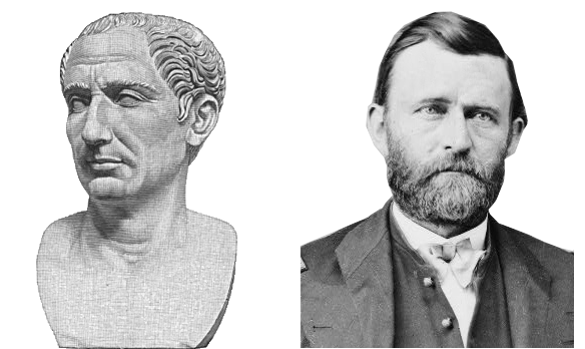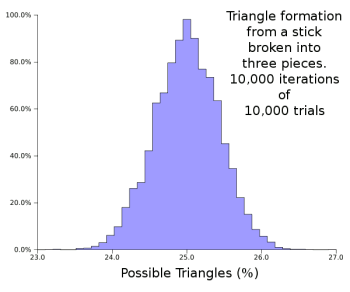Twice Broken Sticks
July 2, 2018
If you ask people to name the most popular
book of
19th century America, many might name
Herman Melville's 1851
novel,
Moby-Dick, more properly
Moby-Dick; or, The Whale. While this book is often hailed as one of the
Great American Novels, it did not sell well in its time. Moby-Dick sold just a few thousand copies, with Melville earning just a little over a thousand
dollars for his effort, which is about $20,000 in
today's money.
The actual best selling American book of that
century (behind the
Bible) was
Uncle Tom's Cabin by
Harriet Beecher Stowe (1811-1896) which sold 300,000 copies in the
United States and a million copies in
Great Britain in the first year of its
publication in 1852. Another best seller was
Mark Twain's 1884
Adventures of Huckleberry Finn.
However, the best
non-fiction work of that century was the
Personal Memoirs of Ulysses S. Grant, written by the 18th
President of the United States,
Ulysses S. Grant (1822-1885), who had served as the
6th Commanding General of the United States Army during the
American Civil War (1861-1865). This book was published by Mark Twain in the year of Grant's
death.
Grant's principal purpose in writing his memoirs was to provide for his
family after being
diagnosed with
terminal throat cancer that was the likely consequence of a
voracious cigar and
whiskey habit.
Abraham Lincoln, when cautioned about Grant's
drinking problem, supposedly requested the name of his favorite whiskey, so he could send a
barrel to each of his
generals.[1]
Motivated by his rapidly declining
health, Grant wrote up to fifty
pages a day and finished the
manuscript five days before his death. Twain made a considerable
profit on Grant's memoirs, which sold hundreds of thousands of copies, but he subsequently lost millions of dollars in today's money on his
investment in the
Paige Compositor, an early
typesetting machine.

Gaius Julius Caesar (100 BC - 44 BC) (left) and Ulysses S. Grant (1822-1885) (right). (Left image, a bust of Caesar from the 1902 book, History of the World, edited by H. F. Helmolt, from Wikimedia Commons, courtesy of The General Libraries, the University of Texas at Austin. Right image, a portrait of Grant taken sometime between 1855 and 1865, from the Library of Congress, American Memory Collection, Digital ID, cwpb 06971, via Wikimedia Commons.)
Grant's memoirs were in a long tradition of
military memoirs that date back to at least the time of
Gaius Julius Caesar (100 BC - 44 BC). Caesar wrote his account of the nine-year
Gallic Wars (58 BC - 50 BC) as a
third-person narrative in the well known book,
Commentarii de Bello Gallico.[2] This book is familiar to
students of
Latin, since its simple
grammar is quite accessible and used to teach the
language. The famous first line of the book, "Gallia est omnis divisa in partes tres" ("Gaul is a whole divided into three parts"), is still remembered by those students after
decades.
Physicists and
mathematicians have had a long
history of things broken into three parts. As I described in a
previous article (Spaghetti in Physics and Math, January 7, 2011),
Physics Nobelist,
Richard Feynman, noticed that when you bend a
strand of dry
spaghetti beyond a critical
bend radius, it breaks, not into two pieces, but three and sometimes more.[3]
Although Feynman
experimented with dry spaghetti in an attempt to explain this effect, his wasn't able to discern its extremely subtle cause. After the first
fracture, into two pieces when the bend radius is exceeded, a
flexural wave travels down the broken pieces to cause subsequent fractures. All this was revealed by
high speed photography.[4-5]
A spaghetti problem in the realm of mathematics involves a dry spaghetti strand broken into three
random lengths. This problem, conceived as far back as 1854, asks the
probability that these three pieces can form a
triangle.[6] It's quite apparent that you can only build a triangle when the
sum of the lengths of any two sides exceeds the length of the third side, a condition known as the
triangle inequality (see figure).

Building a triangle from a broken strand of dry spaghetti, or from a broken stick. (Created using Inkscape)
The probability that a stick broken into three random lengths can build a triangle is only 25%.[6-7] An
analytical solution of this is given in ref. 6, and a
Monte Carlo calculation to verify this is quite simple; so simple, in fact, that even I was able to create a very short
computer program to do this (
source code here). The
histogram of successful triangle builds for 10,000 trials of 10,000 broken sticks appears below.

Histogram of 10,000 iterations of 10,000 trials for success in building a triangle from a stick broken into three pieces. (Click for larger image)
The
saga of the twice broken stick continues, as evidenced by a recent
paper on
arXiv by
Steven R. Finch, a
mathematician at the
Massachusetts Institute of Technology. In this paper, he calculates the
median area for objects built from randomly broken sticks, not only for triangles, but for
quadrilaterals as well. In the case of triangles, the median area is quite small. For a stick of
unit length, the median area is just 0.031458...[8]
The above
truncated decimal for the
calculated median area belies the extreme
precision of the calculation. Finch gives the actual value as 0.0314584607846627648007001...[8] I write this as an example of why you shouldn't be too satisfied with the results of your
computer simulations.
As an example, I wrote a Monte Carlo simulation of this problem (source code
here) that gives a good value on my
desktop computer in a few minutes. My program is not that elegant, so more iterations could be done in a shorter time, but the precision of the computer results are a long way from an actual calculation (see figure).

Histograms of mean and median area computations for random triangles. We can be fairly certain that the median area falls between 0.0313 and 0.0317, but this precision is far behind the value of 0.0314584607846627648007001... of an actual calculation. (Created using Gnumeric. Click for larger image).
References:
- I Will Send a Barrel of This Wonderful Whiskey to Every General in the Army, from Garson O’Tool's Quote Investigator, February 18, 2013.
- G. Julius Caesar, "Commentarii de Bello Gallico," Latin and English texts on Tufts University Project Perseus.
- Feynman's Interest in Spaghetti, from Scott Roberts' heelspurs.com.
- RWD Nickalls, "The Dynamics Of Linear Spaghetti Structures," June 14, 2006 (PDF File).
- Basile Audoly and Sébastien Neukirch, "Fragmentation of Rods by Cascading Cracks: Why Spaghetti Does Not Break in Half," Phys. Rev. Lett., vol. 95, no. 9 (25 August 25, 2005), Document 95.095505 (4 pages).
- Eugen J. Ionascu and Gabriel Prajitura, "Things to do with a broken stick," arXiv, April 20, 2013.
- MIT PRIMES/Art of Problem Solving, CROWDMATH 2017: The Broken Stick Problem.
- Steven R. Finch, "Median Area for Broken Sticks," arXiv, April 25, 2018.
Linked Keywords: Book; 19th century; America; Herman Melville; novel; Moby-Dick; Great American Novel; dollar; inflation; today's money; century; Bible; Uncle Tom's Cabin; Harriet Beecher Stowe (1811-1896); United States; Great Britain; publication; Mark Twain; Adventures of Huckleberry Finn; non-fiction; Personal Memoirs of Ulysses S. Grant; President of the United States; Ulysses S. Grant (1822-1885); 6th Commanding General of the United States Army; American Civil War (1861-1865); death; family; medical diagnosis; terminal throat cancer; voracious; cigar; whiskey; addiction; habit; Abraham Lincoln; alcoholism; drinking problem; barrel; general; health; page; manuscript; profit; investment; Paige Compositor; typesetting; machine; Gaius Julius Caesar (100 BC - 44 BC); bust; Wikimedia Commons; University of Texas at Austin; portrait; Library of Congress; military; Gallic Wars (58 BC - 50 BC); third-person narrative; Commentarii de Bello Gallico; student; Latin; grammar; language; decade; physicist; mathematician; history; Physics Nobelist; Richard Feynman; fiber; strand; spaghetti; bend radius; experiment; experimented; fracture mechanics; fracture; flexural modulus; flexural wave; high speed photography; randomness; random; probability; triangle; addition; sum; triangle inequality; Inkscape; analytical solution; Monte Carlo calculation; computer program; source code; triangle.c; histogram; saga; academic publishing; paper; arXiv; Steven R. Finch; Massachusetts Institute of Technology; median; area; quadrilateral; unit; truncation; truncated decimal; calculation; calculate; precision; computer simulation; triangle median.c; desktop computer; average; mean; Gnumeric.